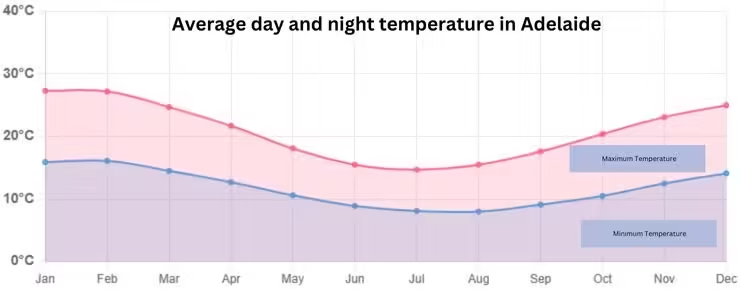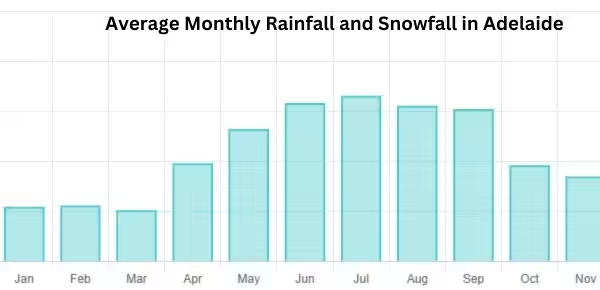The temperature in Adelaide, South Australia, is important for both residents and visitors to understand. Known for its Mediterranean climate, Adelaide has hot, dry summers and mild, wet winters. Knowing temperature trends affects daily activities, agriculture, tourism, and overall lifestyle in the area.
Annual Temperature Overview
Throughout the year, Adelaide experiences different temperatures. During summer, from December to February, temperatures often peak above 30°C (86°F) and can reach over 40°C (104°F) during heatwaves.
People need to take precautions for heat-related issues, especially the elderly and children. In contrast, winter lasts from June to August, with moderate temperatures ranging between 8°C (46°F) and 16°C (61°F). Although frost is rare, residents and visitors should prepare for cooler nights and occasional rain.
Table of Contents
ToggleComparing Adelaide’s Climate
Adelaide’s climate is different from other Australian regions. Cities like Melbourne and Sydney have more rain and humidity, while Perth has a Mediterranean climate with more extreme temperatures. Understanding these differences can help travelers set realistic expectations when visiting Adelaide.
Impact on Daily Life
Being aware of the temperature in Adelaide affects many aspects of life. Tourists can schedule visits around nice weather, while farmers can plan their crops according to seasonal changes. Residents can make informed decisions about daily routines, outdoor activities, and energy use based on temperature predictions. By knowing about Adelaide’s climate, both locals and tourists can enhance their experiences in this vibrant city.
Monthly Breakdown: Temperature in Adelaide from January to December
January
In January, Adelaide’s summer is at its peak. Expect daytime highs often reaching around 29°C (84°F), with occasional heatwaves pushing temperatures above 40°C (104°F). It’s an excellent time for beach activities and outdoor events, but ensure to stay hydrated and seek shade when necessary.
February
As we move into February, the temperature remains similar to January, maintaining highs around 28°C (82°F). February is notable for the Adelaide Fringe Festival, attracting many visitors to the city.
March
In March, the heat starts to taper off slightly with average highs of about 26°C (79°F). It marks the onset of autumn, making it a comfortable time for sightseeing and experiencing events like the Adelaide Festival.
April
April brings more moderate weather with highs averaging 23°C (73°F). The cooler evenings and clear skies make it ideal for walking tours and exploring Adelaide’s vineyards.
May
During May, temperatures continue to drop, with average highs around 20°C (68°F). The autumn foliage adds a picturesque touch to local parks and botanical gardens.
June
June heralds the beginning of winter, and temperatures further decrease to highs of 16°C (61°F) and lows of 8°C (46°F). It’s the perfect time to enjoy indoor activities and explore Adelaide’s cultural landmarks.
July
In July, the coldest month, expect temperatures ranging between 7°C (45°F) and 15°C (59°F). Pack extra layers if you plan to visit during this month, as the evenings can be particularly chilly.
August
By August, the temperature in Adelaide starts to rise slightly, with average peaks of 16°C (61°F). This transitional period is ideal for wine tours in the Barossa Valley, a short drive from the city.
September
As spring begins in September, temperatures climb to around 19°C (66°F). With blooming flowers and mild weather, it’s an excellent time for outdoor festivals and activities.
October
October sees further warming, with temperatures averaging 22°C (72°F). The pleasant climate allows for leisurely outdoor pursuits, including visits to Adelaide Hills and Kangaroo Island.
November
In November, temperatures rise to highs of 25°C (77°F). It’s a vibrant period leading into summer, with numerous events and activities in full swing.
December
Finally, December ushers in the summer season with temperatures averaging 27°C (81°F). The lead-up to the festive period sees an influx of visitors, making it an exciting time to experience Adelaide’s bustling markets and lively atmosphere.
Adelaide, South Australia, experiences distinct seasonal weather patterns. The city has a Mediterranean climate with hot, dry summers and mild, wet winters, offering various activities throughout the year.
Summer (December to February)
Summer lasts from December to February, with temperatures often above 30°C (86°F) and sometimes exceeding 40°C (104°F) during heatwaves. Rainfall is low, making it perfect for beach outings. However, sun protection and hydration are essential.
Autumn (March to May)
Autumn runs from March to May, with temperatures ranging from 15°C (59°F) to 25°C (77°F). Light rainfall increases. However, it’s still enjoyable for vineyard tours in Barossa Valley and hiking in the Adelaide Hills.
Winter (June to August)
Winter, from June to August, sees cooler weather, with nighttime lows around 8°C (46°F) and daytime highs rarely above 16°C (60°F). Rainfall is more common. This makes indoor attractions like museums and cafes appealing during this season.
Spring (September to November)
Spring, which runs from September to November, brings warming temperatures between 11°C (52°F) and 21°C (70°F). The weather becomes drier, and blooming flowers make it an excellent time for outdoor activities and local festivals.
Tips for Visiting Adelaide Based on Temperature and Weather
Summer Tips (December to February)
In summer, from December to February, temperatures often average 29°C (84°F) and can exceed 40°C (104°F). Wear lightweight, breathable clothing and apply sunscreen. It’s also important to wear a hat and stay hydrated. Outdoor activities are best enjoyed during the early morning or late afternoon to avoid the peak heat.
Autumn Tips (March to May)
Autumn offers milder temperatures between 12°C (54°F) at night and 22°C (72°F) during the day. Layered clothing is recommended so you can adjust to changing temperatures. You can enjoy vineyard tours or local festivals during this pleasant season.
Winter Tips (June to August)
Winter, from June to August, has temperatures ranging from 8°C (46°F) to 16°C (61°F). Make sure to pack warm clothing, such as a good jacket, to stay comfortable. This season is ideal for visiting indoor attractions like museums and the Adelaide Central Market.
Spring Tips (September to November)
Spring brings pleasant weather with temperatures between 11°C (52°F) and 22°C (72°F). Light- to medium-weight clothing works well, and a light sweater can be handy for cooler evenings. It’s a great time for outdoor activities in the botanical gardens.
General Tips
Finally, always check local weather forecasts and pay attention to any advisories for extreme weather. With these preparations, you can ensure an enjoyable and safe trip to Adelaide, no matter the season.
Understanding Adelaide’s weather patterns helps in planning an enjoyable visit. Each season brings unique experiences for both tourists and locals.
¦The information in this article may become outdated due to the passage of time. If you notice any errors, please inform us in the comments. This will help us maintain accurate information for our guests¦
Frequently Ask Questions about Temperature of Adelaide
Q1: What type of climate does Adelaide have?
A1: Adelaide has a Mediterranean climate, which means it has hot, dry summers and mild, wet winters.
Q2: Why is understanding temperature trends in Adelaide important?
A2: Knowing the temperature trends affects daily activities, agriculture, tourism, and the overall lifestyle in Adelaide.
Q3: What are the summer temperature ranges in Adelaide?
A3: During summer, temperatures often peak above 30°C (86°F) and can reach over 40°C (104°F) during heatwaves.
Q4: What precautions should be taken during summer in Adelaide?
A4: People should wear lightweight, breathable clothing, apply sunscreen, wear hats, and stay hydrated.
Q5: What are the winter temperature ranges in Adelaide?
A5: In winter, temperatures range from 8°C (46°F) to 16°C (61°F).
Q6: What activities are ideal during Adelaide’s winter?
A6: Visiting indoor attractions like museums and the Adelaide Central Market is ideal during winter.
Q7: How is Adelaide’s climate different from Sydney and Melbourne?
A7: Adelaide is drier with less humidity, whereas Sydney and Melbourne are wetter and more humid.
Q8: What clothing is recommended for autumn in Adelaide?
A8: Layered clothing is recommended to adjust to temperatures ranging from 12°C (54°F) at night to 22°C (72°F) during the day.
Q9: What activities are popular in Adelaide during spring?
A9: Spring is great for outdoor activities and local festivals, thanks to mild weather and blooming flowers.
Q10: What general tips are important for visiting Adelaide?
A10: Always check local weather forecasts and heed any advisories for extreme weather.
Q11: Which season in Adelaide is perfect for vineyard tours?
A11: Autumn is ideal for vineyard tours, especially in the Barossa Valley.
Q12: What should visitors pack for Adelaide in winter?
A12: Visitors should pack warm clothing, including a good jacket for the cooler temperatures.
Q13: What are the temperatures like in autumn in Adelaide?
A13: Temperatures in autumn range from 15°C (59°F) to 25°C (77°F).
Q14: Why might someone visit Adelaide in the summer?
A14: Adelaide in summer is perfect for beach outings and outdoor events, especially if you avoid peak heat times.
Q15: How does knowing Adelaide’s weather patterns help tourists and locals?
A15: Understanding the weather helps plan for an enjoyable visit, enhancing experiences with activities suitable for each season.




